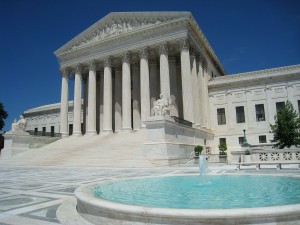Experienced Federal Crime Attorney: Professional Protection in Federal Crime Situations
Experienced Federal Crime Attorney: Professional Protection in Federal Crime Situations
Blog Article
Debunking the Refine of Federal Appeals: What You Required to Know
Navigating the intricate world of federal appeals can typically appear like passing through uncharted waters for those unfamiliar with the procedure. Recognizing the subtleties of appellate court jurisdiction, the details of submitting a notification of appeal, providing a compelling brief, and making an influential dental argument are important parts that can substantially impact the result of a situation. By unraveling the layers of complexity surrounding federal allures, people can acquire a clearer understanding right into the devices that govern this vital phase of the lawful system.
Understanding Federal Appeals Process
Exploring the elaborate realm of the federal charms process unveils a structured and methodical journey via the judicial system. Federal appeals work as an essential mechanism for evaluating decisions made by reduced courts. Recognizing this procedure is crucial for any person associated with legal proceedings at the federal level.
The procedure commonly starts with a celebration dissatisfied with a lower court's ruling filing a notification of charm. This sets off an evaluation by a higher court, where a panel of courts evaluates the legal debates presented by both events. Briefs laying out the legal thinking behind each party's placement are submitted, and dental disagreements might be heard to clarify complicated concerns.
The appellate court's decision is based on a comprehensive exam of the reduced court's procedures and the disagreements provided. As soon as the appellate court reaches a choice, it can verify, turn around, remand, or customize the reduced court's ruling, providing clarity and finality to the lawful dispute.
Appellate Court Territory Discussed
Appellate court jurisdiction refers to the range of situations that a particular appellate court has the power to review and make a decision upon. Unlike test courts that hear cases for the first time, appellate courts are restricted to assessing decisions made by lower courts.
Appellate courts have jurisdiction over details types of cases, typically those involving lawful errors, procedural issues, or inquiries of regulation instead of valid conflicts. The jurisdiction of appellate courts is normally outlined in laws and regulations that control the court system. Understanding appellate court territory is essential for events associated with the allures process as it identifies whether a situation is eligible for evaluation and the level to which the appellate court can interfere in the lower court's choice.
Filing a Notification of Charm
The initial step in commencing the federal appeals procedure includes submitting a Notification of Charm with the appropriate appellate court. This essential record formally informs the court and the other events included in the instance that the appealing event means to seek a review of the lower court's decision. Submitting a Notice of Allure is a rigorous procedural requirement that sets the appellate process in movement.
When preparing the Notice of Appeal, it is important to make sure compliance with the details guidelines and guidelines of the pertinent appellate court. federal crime attorney. The paper should commonly consist of information such as the instance name, the reduced court's name, the date of the judgment being appealed, and a succinct statement showing the grounds for the charm

Rundown and Oral Argument
In the appellate procedure, offering written briefs and engaging in oral arguments play critical roles in supporting for the appealing celebration's placement prior to the appellate court. Briefs are detailed lawful records that outline the celebrations' arguments, legal authorities, and analysis supporting their positions. These written submissions supply the court with a comprehensive understanding of the facts of the situation, the appropriate legislation, and why the appealing celebration thinks the reduced court's decision ought to be overturned.
Adhering to the entry and evaluation of the briefs, oral debates use the events a possibility to more clarify their placements, deal with any type of questions the appellate courts may have, and highlight key points from their composed briefs. Oral debates are a possibility for the attorneys to convince the courts via verbal campaigning for and reactions to inquiries from the bench.
Both the composed briefs and oral arguments are vital components of the appellate procedure, permitting events to offer their situation completely and compellingly prior to the appellate court. - federal crime lawyer
Receiving the Appellate Court Decision
Upon completion of oral arguments and entry of composed briefs, the next crucial phase in the appellate process entails awaiting the crucial ruling from the appellate court. This duration of expectancy can be full of a mix of stress and anxiety and expect parties included in the allure. The appellate court's decision is generally provided in a created layout and outlines the court's verdicts on the lawful problems presented, the reasoning behind their decision, and the judgment made. The moment framework for getting the appellate court's decision can differ, but courts strive to supply timely resolutions. Once the decision is issued, events have to thoroughly assess the court's ruling to understand the end result and establish any more steps that may be needed. Whether the appellate court verifies, turns around, or remands the lower court's decision, recognizing the effects of the judgment is crucial for all events entailed in the appellate process. For that reason, promptly reviewing and comprehending the appellate court's decision is important in browsing the next action in the legal proceedings.
Conclusion
Understanding the appellate court jurisdiction, submitting a notification of allure, preparing briefs, and offering oral debates are all crucial elements of this process. Ultimately, receiving the appellate court choice can offer quality and resolution to legal conflicts.
As we progress from comprehending the federal appeals procedure to dissecting the ins and outs of appellate court territory, a fundamental facet comes to light relating to the authority and restrictions of these higher courts in the legal landscape. Appellate court territory refers to the extent of instances that a specific appellate court has the power to assess and determine upon. Unlike trial courts that listen to situations for the first time, appellate courts are restricted to assessing choices made by lower courts. Understanding appellate court jurisdiction is critical discover here for parties included in the charms procedure as it identifies whether a situation is eligible for review and the extent to which the appellate court can intervene in the reduced court's choice.

Report this page